Atlantic Salmon may soon have a challenger in the form of a native namesake that is the focus of new initiatives from harvesting to product development
By Rose Yeoman
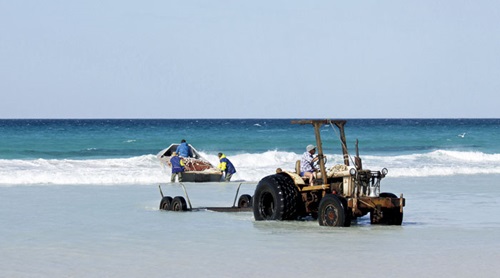 Fishing for Australian Salmon: commercial beach haul netting at Cheynes Beach, 60 kilometres east of Albany, on the south coast of Western Australia.
Fishing for Australian Salmon: commercial beach haul netting at Cheynes Beach, 60 kilometres east of Albany, on the south coast of Western Australia. Weak demand and low prices, rather than reduced fish numbers, have been responsible for the decline in commercial catches of Australian Salmon since the mid-1990s.
However, this could be about to change thanks to a new Australian Seafood Cooperative Research Centre (Seafood CRC) project that is using an existing technology to improve fish quality.
The project is also fostering collaboration between researchers and industry, and contributing to some clever new seafood product development.
Western Australian Salmon (Arripis truttaceus) is a sea perch from the family Arripidae. It is closely related to its eastern counterpart Arripis trutta (Eastern Australian Salmon), but despite the name, neither are related to the true Salmon – including Atlantic Salmon (Salmo salar) – of the family Salmonidae. Australian Salmon is only one of many underutilised finfish species that will be included in the database developed as part of this Seafood CRC project.
The database will include challenges specific to each of the underutilised species that make it difficult to bring a reliable quantity of quality product to the marketplace.
Janet Howieson, from the Centre of Excellence for Science, Seafood and Health (CESSH) at WA’s Curtin University, is co-investigator on the project and says Australian Salmon is the first species to be studied in depth.
As manager of the post-harvest supply-chain improvement program at CESSH, Janet Howieson’s focus is to improve the performance of seafood supply chains through science and innovation. This includes the development of new seafood products, which she says need to be driven by end users.
Each year in Australia, about 25,000 tonnes of finfish that could be sustainably harvested are overlooked. Janet Howieson says the reasons for this are diverse.
For example, sardines and Australian Salmon both have a comparatively short shelf life. They require an exacting supply chain to reach the market in good condition.
“This means they must be caught and processed quickly so they reach the market in the shortest possible time to maintain their quality,” she says.
Other species might only be found in remote locations where there is a lack of infrastructure, such as chilled or frozen storage space, to harvest and process them, and bring them to markets in good time and in good condition. And if market demand for a specific species is relatively weak, when additional tonnages are harvested the fish are destined for lower-value product such as bait and aquaculture feed.
Consumer perceptions can also be a challenge. Australian Salmon has been perceived as an “average” eating fish. However, when processed quickly and served in the right way, consumers have rated it close to Barramundi (Lates calcarifer) in desirability.
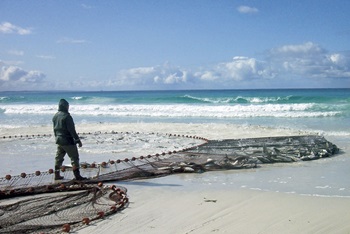
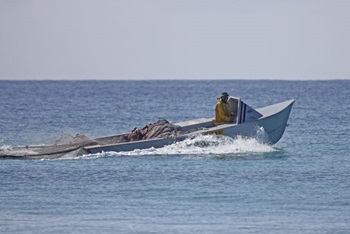 Photos: Raeline Smith
Photos: Raeline Smith Harvesting challenge
Early in the analysis of Australian Salmon, an industry development group was formed and fishers, processors and marketers held a workshop to identify the best practice processes that would bring fish to market in the best possible condition. This included the need to process fish as quickly as possible to maintain flesh quality.
Studies show that when a fish dies slowly, it runs out of oxygen, which leads to a build-up of lactic acid in the tissues. This produces opaque flesh and lowers pH, causing sour-tasting fish. It also makes the flesh soft, which means a shorter shelf life.
Avoiding such pitfalls and harvesting to promote quality is a fundamental step in the chain of events leading to quality marketable Australian Salmon products.
The Australian Salmon industry group looked at what other sectors of the seafood industry were doing to maintain quality, including processes to kill fish quickly and without causing them stress. A portable ‘stunning machine’, the size of a large office desk, emerged as the possible key to revolutionising the Australian Salmon industry in WA.
Originally developed by Queensland company Seafood Innovations for the Atlantic Salmon industry in Tasmania, it uses compressed air to stun fish. Fisheries scientist and Seafood Innovations founder Bruce Goodrick explains that in order to preserve good eating quality, a fish’s environment should be as natural as possible until the second it dies.
With this in mind, his company, now owned by Baader and known as Baader Seafood Innovations, developed a series of stunning machines that simulate an environment where fish are enticed to swim into the stunning machines. The machine then delivers a high-speed blow to the skull.
Considered to be one of the most humane and efficient ways of killing fish, the technique is known as ‘percussive stunning’. If fish entering the machine are all the same species, the same level of stunning may be used for fish ranging from one to 15 kilograms.
A trial with Australian Salmon was held at Bettys Beach on WA’s south coast, where fish were harvested with beach haul nets. Fish were taken from the nets on the beach, stunned, hand bled and placed in ice slurry for transport to a processing plant in Albany. A total of 1.4 tonnes of frozen fish was produced for market trials and new product development.
Salmon products
Value-added products produced from the ‘quality’ fish samples included eight flavours of canned smoked Australian Salmon, an Australian Salmon fish burger and Thai fish cakes with 100 per cent Australian fish. A dog-food range of dried slices and cuts and seafood jerky have been suggested but not yet developed.
Janet Howieson reports that chef Dale Sniffen experimented with hot-smoked Australian Salmon and took samples to his fly fishing club. “The response was overwhelmingly positive,” she says. “The samplers were intrigued by the excellent flavour – they could not tell whether it was cobbler, flathead, queen snapper or some other fish.”
Dale Sniffen also developed ‘Australian Fish Cakes’ and ‘Australian Thai Fish Cakes’ from frozen vacuum-packed loins. These are a cost-effective use of product and have been well received by consumers.
In a consumer taste trial at Curtin University, microwaved frozen fillets of Australian Salmon were presented alongside similar products of Spanish Mackerel (Scomberomorus commerson), Barramundi, mullet, snapper and whiting. Overall, the salmon was fourth in preference, but close to Barramundi.
In another survey, also at the university, 83 per cent of respondents said they would be more likely to choose products from a well-managed fishery and 66 per cent said they would pay a premium price for them.
Project partners
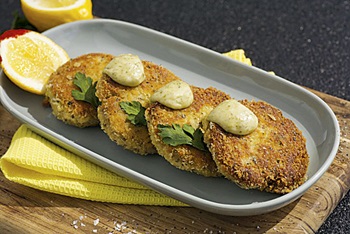
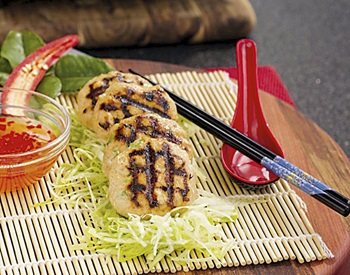
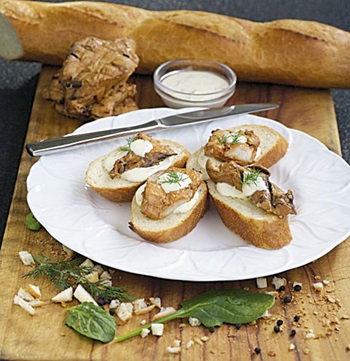 (From top) Cost-effective 100 per cent Australian Fish Cakes and 100 per cent Australian Thai Fish Cakes made from Australian Salmon loins, and hot-smoked Australian Salmon pieces, all created by chef Dale Sniffen.
(From top) Cost-effective 100 per cent Australian Fish Cakes and 100 per cent Australian Thai Fish Cakes made from Australian Salmon loins, and hot-smoked Australian Salmon pieces, all created by chef Dale Sniffen.Photos: Janet Howieson, Curtin University
Janet Howieson says the support of industry partners for her work has been crucial. One partner is Garry Bevan, of Bevans (WA) Pty Ltd, the only export-registered fish-processing plant in Albany. Bevans exports to South-East Asia.
Bevans has sent the ‘quality’ market samples of frozen whole fish, headed and gutted fish, fillets and loins to South Korea, Thailand, China and Hong Kong and while there are no confirmed orders as yet, a second and larger quantity of samples has been sent for further assessment.
Garry Bevan is optimistic: “There’s a shortage of protein in the world and Australian Salmon comes from the pristine waters of the Southern Ocean. If handled and processed correctly, it will be desirable,” he says. “Setting up the supply chain correctly and providing a consistent supply would be crucial.”
Catalano’s Seafood is a WA fish processor, wholesaler, retailer and exporter. The business has developed a jarrah-smoked Australian Salmon, which should reach the market within a year.
Managing director Nick Catalano says: “Without Janet’s help we would not have gone down this path. We want to offer the fishery an alternative market and we’re satisfied with the first stage of R&D and that we have a product for human consumption. The texture stands up well to smoking.”
Nick Catalano is clear about the value of promoting sustainably fished products.
“Our objective is to process Australian, especially Western Australian, product and we see the Australian Salmon fishery as sustainable. There’s no point putting energy into a non-sustainable fish.”
Fisher and processor Tony Westerberg has created tinned value-added products as his contribution to the project. Taste tests have identified two flavours – Penang curry and matsaman – as being most desirable and he hopes to launch the product within the next six months.
The future
Les Pinninger is a long-time professional fisher on WA’s south coast who counts Australian Salmon as part of his catch. He says fishers are very interested in developing a range of new markets. “They’re willing to adjust their methods of handling and potential volume of catch to meet market expectations, particularly to achieve improved quality,” he says.
John Harrison, CEO of the Western Australian Fishing Industry Council, also sees a lot of potential for the WA Salmon fishery. “I am a firm believer that we’ve got an opportunity to provide real value-adding to a product historically regarded as somewhat low in value,” he says.
“We’ve got an opportunity to fit into a marketplace where it is becoming increasingly difficult to purchase wild-harvest fish.
“A high-quality fish at lower cost will fit well into the shopping cart of those who cannot afford premium-priced product. It’s Australian, attractive in taste and likely to be competitively priced. And there’s the potential to stimulate the economy, as this fishing industry will be economically viable.”
Janet Howieson says an increased and more valuable market share will be possible as fishers optimise their harvesting techniques, quality management and supply volumes.
“There will also need to be an increased infrastructure capacity in Albany to manage increased harvest volume,” she says. “Work is continuing with the industry development group on these issues, as well as the value-added product development and on exploring new markets.”
The underutilised finfish species database is expected to be complete by mid-2015, although new species may be added as market conditions change. Two or three other underutilised species from the database will be chosen for further work.
Stakeholder consultation has so far provided positive responses with producers in Esperance, the Pilbara trawl and the Great Australian Bight requesting project development for other finfish species.
However, case-study species selection will also be dependent on whole-of-chain commitment from producers, processors and retailers or other end users. Janet Howieson says this aspect is essential for the successful launch of new seafood products.
FRDC Research Codes: 2013-711, 2013-214
More information
Dr Janet Howieson, 08 9266 2034, 0423 840 957
j.howieson@curtin.edu.au





